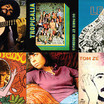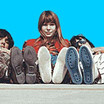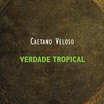Eubioticamente atraídos
the explosion of “alegria, alegria”
Historic Press
THE EXPLOSION OF “ALEGRIA, ALEGRIA”
Augusto de Campos
Published in O Estado de Paulo, November 25, 1967.
“Alegria, Alegria” (Joy, Joy), by Caetano Veloso seems to take on at this moment an importance similar to “Desafinado” (Out of Tune) as an expression of a critical position taking in relation to the paths of Brazilian popular music. ln their defense of the “anti-musical behavior” of those who are “out-oftune,” Newton Mendonça and Tom Jobim (via João Gilberto) put into that composition the theory ractice of a movement: the sentimental exclamation of “Desafinado” (very well harmonized, as a matter of fact) was well understood as a manifesto against the ices of classical harmony that prevented a supposed interlocutor (or of the public, at that point) from accepting as “harmonized,” as familiar or “musical,” the dissonant harmonies of bossa nova. The explosion of “Alegria, Alegria” has the feeling of a new exclamation-manifesto, important than ever, in the face of the crisis of insecurily that has created a number of prejudices and taken hold of Brazilian popular music, threatening to interrupt its evolutionary marcho lt is a crisis that has become more acute in recent years, with symptoms of fear and resentment, in relation to the musical phenomenon of the Beatles, their international projection, and their local impact on the music of the Jovem Guarda.
By refusing to opt between the “holy war” against iê-iê-iê or the ostrich-like behavior (feigning ignorance or disdaining the emergence of musicians, composers and interpreters. Who often have great sensibility even when they are not truly innovative, such as the Beatles in the genre of “young people’s music”), Caetano Veloso and Gilberto Gil with “Alegria, Alegria” and “Domingo no Parque” (Sunday in the Prk have proposed, in na Oswaldian way, “to digest” that wich is new in these mass and youth movements and to incorporate the achievements of modern popular music in their own work without abdicating formal principles in their compositions, which are clearly founded on northeastern musical roots.
One could say that “Alegria, Alegria” and “Domingo no Parque” represent complementary sides of the same attitude, the same movement: they both attempt to liberate national music from the closed system of supposedly “nationalist” prejudices that in truth are merely solipsist and isolationist. Like early bossa nova compositions, they exemplify freedom of research and experimentation, which are essential, even in art for mass consumption such as popular music, in order to avoid stagnation.
But it is “Alegria, Alegria” that most clearly states this critical postulate, stamped in its lyrics. For this very reason, in the larger context of Brazilian popular music, the “Why not?” in the verse afilie song took on the characteristics of an exclamation-challenge. And it was in that sense that the composer, accompanied by the Beat Boys in the first presentation of the song, would triumph over the prejudiced disapproval with which the audience received the band and would end up exclaiming at the end, arms opened to the conquered audience, “Why not?”
Going against the redundant tide of acoustic guitars and “Marias,” the lyrics of “Alegria, Alegria” evoke the unforeseen aspects ofurban reality, which are multiple and fragmentary. In the lyrics, isomorphically caprored noun- fragments from the moder information implosion predominare: crimes, space ships, guerillas, cardinals, the faces of presidents, kisses, teeth, legs, flags, the bomb, and Brigitte Bardot It is the world of newsstands, of so much news,” theworld of high. speed communication, and of the “information mosaic” to which Marshall McLuhan refers. In this sense, one could say that “Alegria, Alegria” takes the opposite path of “A Banda” (The Band) [a song by Chico Buarque that won first prize in the previous edition of the festival]. Of the two songs, “A Banda” immerses itself in the past in the evocative search for the purity of marching bands and park gazebos. “Alegria, Alegria,” on the other hand, is drenched with the present and is directly involved in the day-to-day aspects of moder, urban communication in Brazil and the rest of the world.
Like Gilberto Gil’s wonderful lyrics to “Domingo no Parque,” Caetano’s have cinematographic characteristics. Yet, as Décio Pignatari remarked to me, while the lyrics of Gil are reminiscent of Eisensteinian montage, with his close-ups and fusions (“the ice cream is strawberry -it is red – oh spinning and the rose – it is red oh spinning, spinning – look at the knife! Look at the blood on the hand -its José! Juliana on the floor- it’s José! another body fallen -it’s José! his friend João -it’s José”), Veloso’s are hand-held-camera lyrics, more in the informal and open fashion of Godard, absorbing casual reality “in between photos and names.”
The adversaries of the “universal sound” of Caetano and Gil have misunderstood the problem of innovation in these compositions. It is not about merely adding electric guitars to Brazilian popular music as a superficial adomment. The dislocation of instruments associated with the Jovem Guarda to the arena of Brazilian Popular Music (MPB) already has a “meaning” that is “new information” and it is so disturbing that there were many people who were aurally confused to the point that they could not perceive in which rhythm “Alegria, Alegria” was being played. The electronic sonorities amplify the acoustic horizons of the listener to a musical universe where dissonance and noise are commonplace. On the other hand, even though simple, the melody of”Alegria, Alegria” doesn’t abandon the use ofthe large and unexpected musical intervals that are an innovative characteristic of Caetano’s songs (“Boa Palavra” and “Um Dia”). For its part “Domingo no Parque” plays with greater complexity in terms of musical arrangement: in the definitive recording, the composition is a true assemblage of documentary fragments (noise from the park), “classical” instruments, and a markedly regional rhythm (Capoeira), with the berimbau interecting marvelously with the electric instruments and typical vocalization of Gil in counterpoint to the choral accompaniment of “youth music” – a montage of noises, words, sounds, and cries.
And here one should remember the essential contribution of the arranger Rogério Duprat, in end of itself a turning point for Brazilian popular music. The collaboration between a composer of popular music and a composer of the avant-garde (even though Rogério doesn’t like to be called that, his Knowledge and practice of contemporary high musical culture justifies this classification) was na event that many would have guessed impossible. This encounter, which was so successful, demonstrates that there are no rigid barries between popular music and erudite music any more. Didn’t Paul McCartney’s electric guitar discover the “electronic” Stockhausen? Even Though popular music essentially words at the level or redundancy (that, in terms of information theory is contrary to innovation) – which is inherent to any communication with a large audience – it doesn’t escape the general law of the “aesthetic of forms,” defined by A. Moles as a dialectic between the banal and original foreseeable and unforeseeable redundant and informative. Therefore, its rapprochement to avant-garde erudite music, which, on the contrary, works exclusively with original information, can only have beneficial effects on popular music, making its composers and listeners more demanding, providing popular music with a greater significance than mere entertainment.
In an interview with Dirceu Soares (“Music is Gil is pop, music is pop is Veloso,” jornal da Tarde, October 20, 1967), Gilberto Gil sought to define his and Caetano Veloso’s new compositions as “pop music.” The expression is debatable bacause pop art already has a defined meaning in the field of visual art and could suggest a relation of dependente that doesn’t really exist beyond certain affinities. But Gil’s explanation demonstrates that he knows quite well what he wants. ltis worth repeating: “pop music,” he says, “is music that succeeds in communicating in a simple way such as a street sign, a billboard, a traffic signal, a comic book.” “Domingo no Parque” plays with words, music, sound, and idea, in a montage within the parameters of modern communication: the layout, the arrangement, the final art. According to Gil, in “Alegria, Alegria” “the words with comtemporary meaning and interest – guerilla, Brigitte Bardot, Coca-cola, faces of presidents, space ships – awaken and guide the perception of people towards the total meaning of the things that are being said. And the familiarity, the sense of participation in Veloso’s creation transforms “Alegria, Alegria,” suddenly, into a song of consciousness of an entire urban middle class in Latin America.”
Put in these terms, the position of Caetano and Gil is quite close to that of the Brazilian avant-garde. And especially to the postulates of concrete poetry, intimately related to the avant-garde music of São Paulo, that finds in Rogério Dupra, Damiano Cozzella, Willy Corrêa de Oliveira, and Gilberto Mendes its most talented composers. In the manifesto “Nova Poesia: Concreta” wrltten by Décio Pignatari in 1956, there were already indications afilie anthropophagy of Oswald de Andrade: america of the south america o fthe sun america of salt. a general art of language, propaganda, radio, television, cinema, a popular art, the importance ofthc cyc in high-spccd communication: from luminous advertisemmts to cartoons. […] thc collaboration of visual arts, graphic arts, typography. the duodccaphonic scrics (anton webem) and clectronic music (boulez, stockhauscn), the cinema. points of reference.
There wilI be no lack of advice and admonishments by “hardliners” who wam against the risks of the creative adventore of Caetano and Gil, just as there was no lack of such warnings when bossa nova and concrete poetry emerged. A short time ago, I read an article whose title is symptomatic: “It is dangerous to have ‘alegria, alegria.'” It reminded me of those depressed judges from the poem by Mayakovsky who wanted “to enclose in a circle ofincisions I the birds, the women and laughter.”
And it is precisely against this, against this kind of real, that the song-manifesto of Caetano Veloso sends its message. In the stage of development of our music, the discrimination proposed by the “nationalists” wilI only permit us to provide musical raw material (exotic rhythms) for foreign countries. Bossa nova put an end to this state of things, transforming Brazil into an exporter, for the first time, offinished products from its creative industry and having composers like Jobim and interpreters like João Gilberto respected as the masters.
If these innovators had listened to the advice given to them at the time, which warned of the dangerous of being out of tone, out of tone, and only saw in bossa nova the jazzification of our music, we would continue exporting until today “voodoo for tourists, ” as Oswald would say.
It is necessary to be dane With this defeatist mentality, which claims that an underdeveloped counny can only produce underdeveloped art. Brazilian artistic production (which doesn’t exclude, in a counny with social classes as diversified as ours, the authentic regional element -not mimicked by urbane Sebastianist authors) had matured by 1922., and universality, by 1956. There is absolutely nothing to fear. One can and should move forward freely. And therefore, there is no reason to refuse any of the resources of moder technology from more developed countries: electric instruments, montage arrangements, new sonorities. I don’t believe that it is necessary, right now, to breakt he guitar since João Gilberto’s is still the slogan and the rudder of all of our music. But breakin traditions and taboos is the least of it. “Let me go, let me yelI,” the old advertisement said, rediscovered and transformed into a happening by Décio Pignatari, Damiano Cozze Rogério Duprat, and Sandino Hohagen. Let our music go. Without shackles and without prejudices. Without a handkerchief and withot papers.























